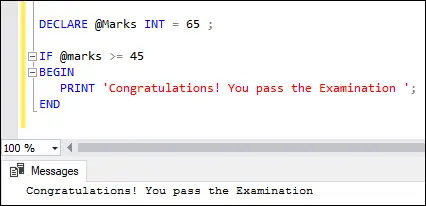IF-satsen är en del av kontrollflödesfunktionen i SQL Server. Vanligtvis är det ett beslutsfattande uttalande i olika programmeringsspråk som returnerar ett värde baserat på de givna villkoren . Denna sats exekverar koden som skrivits i IF-blocket när det givna villkoret utvärderas till sant och när villkoret utvärderas falskt, kommer ELSE-satsen att exekveras.
IF-utlåtandet
Följande är syntaxen som illustrerar användningen av denna sats i SQL Server:
IF boolean_expression BEGIN { statement_block } END I ovanstående syntax är statement_block i BÖRJA...SLUT blocket exekveras när booleskt_uttryck är nöjd med skicket. Annars hoppas detta block över, och programkontrollen flyttas till satsen efter SLUTET nyckelord. Vi bör veta att om uttrycket innehåller a VÄLJ uttalande måste vi bifoga dem inom parentes .
bourne-igen-skal
Exempel
Låt oss se exemplet för att förstå IF-satsen utan ELSE-block. Exemplet nedan visar resultatet när villkoret är uppfyllt. I annat fall flyttade programkontrollen till satsen efter nyckelordet END, om någon.
DECLARE @Marks INT = 65 ; IF @marks >= 45 BEGIN PRINT 'Congratulations! You pass the Examination'; END
Att köra satsen ger följande utdata:
kan en klass utöka flera klasser

Nu kommer vi att visa det på nedan ' Studerande' tabell med följande data:

Nedan är ett annat exempel som får totalt antal poäng av en utvald student från ' Studerande' tabell i exempeldatabasen och skriver sedan ut en meddelande om den är mer än 400 .
BEGIN DECLARE @Total_Marks INT; SELECT @Total_Marks = total_marks FROM Student WHERE age>25; SELECT @Total_Marks; IF @Total_Marks > 400 BEGIN PRINT 'Congratulations! You pass the Examination'; END END
Vi kommer att få följande utdata:

Om vi vill se ovanstående utdatameddelande bör vi klicka på Meddelanden flik:

IF-ELSE uttalandet
I det verkliga scenariot måste vi utföra någon åtgärd när villkoret i IF-satsen är TRUE eller FALSE. I det här fallet är IF…ELSE-satsen användbar. Denna sats exekverar ELSE-satsblocket när villkoret i IF-satsen utvärderas FALSE.
Följande är syntaxen som illustrerar användningen av IF ELSE-satsen i SQL Server :
xor c++
IF expression BEGIN Statement block -- It executes when the IF clause expression is TRUE. END ELSE BEGIN Statement block -- It executes when the IF clause expression is FALSE. END
Exempel
Låt oss se exemplet för att förstå IF-satsen med ELSE-blocket. I exemplet nedan visas meddelandet ' Grattis! Du klarar provet ' när IF-villkoret är uppfyllt. Annars, visa ' Du är misslyckad! Bättre lycka nästa gång '.
DECLARE @Marks INT; SET @Marks = 65; IF @marks <45 begin print 'congratulations! you pass the examination'; end else 'you are failed! better luck next time'; < pre> <p>Executing the statement will give the below output. Here, the <strong>marks</strong> variable is <strong>65</strong> , and the <strong>condition (65<45)< strong> is not satisfied. Therefore, the message inside the ELSE block is displayed:</45)<></strong></p> <img src="//techcodeview.com/img/sql-server-tutorials/49/sql-server-if-else-5.webp" alt="SQL Server IF ELSE"> <p>We will get this output because the condition <strong>(65>45)</strong> is satisfied. Therefore, the message inside the IF block is displayed:</p> <img src="//techcodeview.com/img/sql-server-tutorials/49/sql-server-if-else-6.webp" alt="SQL Server IF ELSE"> <p>Now, we will demonstrate the IF ELSE statement on the above ' <strong>Student'</strong> table. In this example, we are going to check whether the student <strong>total marks</strong> is <strong>greater than or equal to 400</strong> or not as follows:</p> <ul> <li>When the IF condition is TRUE, we will get the student records whose total marks are greater than or equal to 550.</li> <li>If the condition is FALSE, we will get the student records whose total marks are less than 550.</li> </ul> <p>Here is the program:</p> <pre> DECLARE @Marks INT; SET @Marks = 600 ; IF @Marks >= 550 BEGIN SELECT id, name, gender, age, total_marks FROM Student WHERE total_marks >= 550 ORDER BY age ASC END ELSE BEGIN SELECT id, name, gender, age, total_marks FROM Student WHERE total_marks <550 order by age asc end < pre> <p>In this code, we have specified the <strong>@Marks</strong> variable to <strong>600</strong> , and the condition (600 >= 550) is satisfied. Therefore, we will get the output where student records whose total marks are greater than or equal to 550 are displayed.</p> <img src="//techcodeview.com/img/sql-server-tutorials/49/sql-server-if-else-7.webp" alt="SQL Server IF ELSE"> <p>If we changed the <strong>@Marks</strong> variable to <strong>500</strong> and the condition (500 >= 550) becomes false. Therefore, we will get the output where student records whose total marks are less than 550 are displayed.</p> <img src="//techcodeview.com/img/sql-server-tutorials/49/sql-server-if-else-8.webp" alt="SQL Server IF ELSE"> <h2>Nested IF ELSE Statement</h2> <p>Unlike other programming languages, we can nest an IF...ELSE statement inside another IF...ELSE statement in SQL Server. Let us demonstrate it with the following example:</p> <pre> DECLARE @age INT; SET @age = 6; IF @age <18 50 print 'you are underage'; else begin if @age < below 50'; senior cetizen'; end; pre> <p>In this example, we are going to check whether the <strong>age is underage, below 50, or senior citizen</strong> as follows:</p> <ul> <li>If the value of the <strong>@age</strong> variable is below <strong>18</strong> , it will print the person is <strong>underage</strong> .</li> <li>If the condition is FALSE, the ELSE part will be executed that has a nested IF…ELSE.</li> <li>If the value of the <strong>@age</strong> variable is under <strong>50</strong> , it will print <strong>below 50</strong> . Finally, if no condition is satisfied, it will print <strong>senior citizens</strong> .</li> </ul> <p>Here is the result:</p> <img src="//techcodeview.com/img/sql-server-tutorials/49/sql-server-if-else-9.webp" alt="SQL Server IF ELSE"> <p>This article gives a complete overview of how to use the SQL Server IF ELSE statement. Here we have learned:</p> <ul> <li>Variables are objects that serve as placeholders.</li> <li>The keyword BEGIN will be used to start a statement block, and the END keyword must be used to close it.</li> <li>The use of ELSE in an IF... ELSE statement is optional.</li> <li>It's also possible to nest an IF...ELSE statement inside another IF...ELSE statement. However, nesting an IF statement within another statement is bad practice because it makes the code difficult to read and maintain.</li> </ul> <hr></18></pre></550></pre></45>
